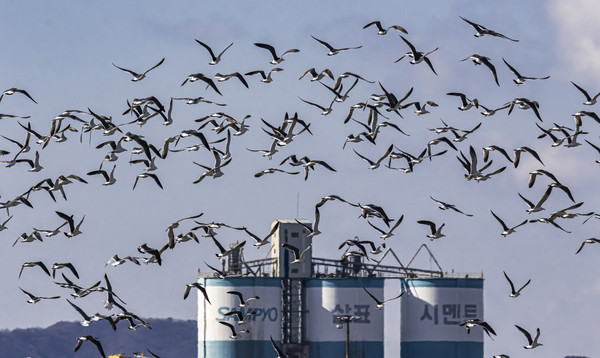Says Bird-wathcer Kim Heung-lok
Birdwatching photographer, Kim Heung-lok, has been engrossed in watching birds and taking their pictures for decades. He has prepared a complete set of cameras to capture every minute and shape of all kinds of birds in the countryside of Korea.

He says: “I go out to the countryside whenever I have time to watch birds and take them into my camera.” He says that bird-watching helps him maintain good health in the mind as well as the body.
Photographer Kim works as a securityman at an apartment building where he is popular for his courteous manners for the occupants of the building and also the visitors to the building with cars.

He is well known for his special care for the visitors to the building as well as for the occupants of the apartement.
He takes special care for the birds as well as he does for the occupants at the partment and all the visitors to the building.
Birdwatching, or birding, according to Wikipedia, is a form of wildlife observation in which the observation of birds is a recreational activity or citizen science. It can be done with the naked eye, through a visual enhancement device like binoculars and telescopes, by listening for bird sounds, or by watching public webcams.
Birdwatching often involves a significant auditory component, as many bird species are more easily detected and identified by ear than by eye. Most birdwatchers pursue this activity for recreational or social reasons, unlike ornithologists, who engage in the study of birds using formal scientific methods.

The first recorded use of the term birdwatcher was in 1891; bird was introduced as a verb in 1918. The term birding was also used for the practice of fowling or hunting with firearms as in Shakespeare's The Merry Wives of Windsor (1602): "She laments sir... her husband goes this morning a-birding." The terms birding and birdwatching are today used by some interchangeably, although some participants prefer birding, partly because it includes the auditory aspects of enjoying birds.
According to an account by Fat Birder, the Republic of Korea (south) is known as one of Asia’s Top New Birding Destination. More than 475 species so far recorded in South Korea (with a new species added almost every month).

Global birding highlights include the world’s highest concentrations of Baikal Teal Anas formosa, Spoon-billed Sandpiper Calidris pygmaea and Nordmann’s Greenshank Tringa guttifer; breeding Chinese Egret Egretta eulophotes and Black-faced Spoonbill Platalea minor; the world’s most accessible wintering Red-crowned Cranes Grus japonensis, Saunders’s Gull Larus saundersi and Relict Gulls Larus relictus; and some of the biggest concentrations of spring and autumn migrants, with peak counts of 50,000 Great Knot Calidris tenuirostris, 3,000 Olive-backed Pipits Anthus hodgsoni in a day, hundreds of warblers and buntings.
Lacking real endemics but high in star quality and numbers (how about a single swarm of 300,000 Baikal Teal?); South Korea is a great country for visiting birders. Safe, friendly, only 450km north to south and roughly the same west to east, the country’s best areas are now linked up by good infrastructure, and nowhere, with some good planning, is more than a day away.
Much of the best habitat is concentrated along the coasts (either western tidal-flats and reclamation lakes for water birds and offshore islands for passerines; or the rocky eastern coast and headlands for seabirds); with a few extra species also found on rivers (Scaly-sided Merganser Mergus squamatus and Mandarin Duck Aix galericulata); in forests or scrub (Siberian Accentor Prunella montanella and Pallas’s Rosefinch Carpodacus roseus); or more open country (Cinereous Vulture Aegypius monachus and Steller’s Sea Eagle Haliaetus pelagicus). South Korea: a great birding destination!

The Korean Birdwatcher’s Year:
Usually the first bird that visitors see is the extraordinarily common Black-billed Magpie. Most tidal-flats or rivers support Black-tailed Gull, Grey Heron and Great Egret, along with Spot-billed Ducks, which breed widely in rice-fields and reedy wetlands. In even small town parks Eurasian Tree Sparrows and Oriental Turtle Doves are very common, while larger areas will also hold flocks of Vinous-throated Parrotbills, the striking Daurian Redstart, and genuine Ring-necked Pheasant.
Taller trees inevitably contain Brown-eared Bulbuls and Great Tits, while Oriental Greenfinches prefer allotments and overgrown riverbanks, which often also conceal Black-crowned Night Herons. More extensive mature woodland, like Gwangeung Arboretum, can hold Great Spotted, White-backed and Japanese Pygmy Woodpeckers plus the regionally endemic Varied Tit. Gravelly rivers in the south and east support Long-billed Plover and Japanese Wagtail. Large-billed Crows and Azure-winged Magpies are resident and visible in mountainous areas and along the south coast.
These representative species are joined seasonally by a very wide number of migrants: of the 475 or so species of bird recorded in Korea, less than 40 can be considered truly resident…
December and January: In occasional periods of extreme cold many smaller rivers and reservoirs freeze over. Temperatures often drop to –5 C at night, and stay near freezing in the day. Periods of light snow and severe cold are usually followed by milder temperatures, and then severe cold again.
An organised winter tour can expect about 160 species in 12 days if all the best areas are visited, and winter specialities include Baikal Teal and Scaly-sided Merganser, Swan and Lesser White-fronted Goose, Steller’s Sea and Eastern Imperial Eagle, Relict and Saunders’s Gull and Solitary Snipe! Red-crowned Cranes stand out on tidal-flats at Ganghwa in the northwest, while White-naped and Hooded Cranes can be found in the south. Huge numbers of ducks and geese fill west coast sites like Haenam and Seosan’s Cheonsu Bay. Siberian Accentors can be common. On the southern island of Jeju milder conditions allow White’s and Pale Thrushes, Olive-backed Pipits, and Red-flanked Bluetails to overwinter along with Korea’s only regular winter Black-faced Spoonbills, and several thousand Mandarin Duck.
FebruaryCold winters mean both temperatures and birding are similar to January, while mild winters are marked by brief spells of rain or sleet, often followed by warmer sunshine, with maximum temperatures rising to 15 C in the southeast.

Many wildfowl are on the move by mid-month, including one or two Baer’s Pochard. Tundra Beans, Greater White-fronted and usually Swan Geese can be found at the Han-Imjin near Seoul. Most Baikal Teal start to depart and can be difficult to find in southern locations. Rooks and Daurian Jackdaws begin to move back into the Nakdong valley and near Gunsan. February sees the start of crane migration, with Hooded and White-napeds moving into South Korea from Japan. Relict and Saunders’s Gull peak at several sites. In the right weather conditions large numbers of Ancient Murrelets and a few Rhinoceros Auklets move north off Guryongpo on the east coast. At the end of the month the first migrants, such as Far Eastern Curlews, Hoopoes and Japanese Lesser Sparrowhawks, arrive.
MarchMarch often contains a mixture of dry, cold days (with night temperatures down to 3-4 C, and highs between 10 and 15 C) and occasional milder showery, windy weather.
In March Falcated Duck regularly display on reservoirs and ponds. Most wintering species are still present, but in progressively reduced numbers. Small numbers of shorebirds, including early Great Knot arrive, plus Siberian Buff-bellied Pipits and the first leucopsis White Wagtails. Hundreds of Rustic Buntings, Dusky and Naumann’s Thrushes move north-east out of China into Korea. Bramblings and Siskins also often form large flocks at key migration points. Sunny days tempt Rustic, Meadow, and Yellow-throated Buntings into song.
April One of the very best birdwatching months! Cold days and nights (lowest day maxima of ca 12 C) gradually warm through the month (reaching the low 20s C by month’s end); and dry spells interspersed with 1-2 days of heavy rain and stormy conditions produce great birding towards month’s end.

